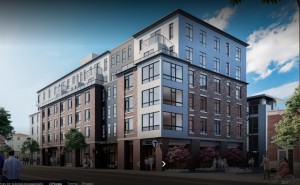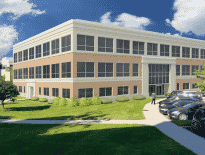It was billed as a groundbreaking strategy to provide much-needed equity for developers of walkable and transit-friendly housing projects in Boston and Massachusetts’ economically vulnerable communities.
Three years passed before the initial Healthy Neighborhoods Equity Fund (HNEF) closed its first $22.35 million round of funding in May 2017, as banks grappled with an unfamiliar risk and reward profile before committing investments. HNEF managers reduced the target from an initial $30 million, and reached out to foundations for a second tier of capital as risk protection.
With $18 million now deployed, the fund’s payoff is becoming evident in its role supporting six projects totaling nearly $160 million in development costs and generating nearly 350 apartments and condos from Beverly to Braintree.
“This was a unique concept,” said Kathy McGilvray, director of investment for Massachusetts Housing Investment Corp. “The few healthy community models out there were debt funds, but after we were able to close a few projects in the construction phase, banks could see it was a pioneering model.”
HNEF is now reviewing a request for funding from Boston-based Traggorth Cos. for its second downtown Haverhill project, this one consisting of 24 loft apartments at 87 Washington St.

Steve Adams
Checking the Boxes to Gauge Impact
The fund is jointly run by the Conservation Law Foundation and Massachusetts Housing Investment Corp., a private nonprofit bank consortium that’s supported affordable housing since 1990. Maximum investments are limited to $5 million per project. The 10-year fund targets returns of 8 percent for its class A investors.
HNEF was conceived as a way to fill funding gaps and help developers finance projects in transitional neighborhoods. But unlike traditional housing incentives, HNEF also seeks to close disparities in health outcomes caused by income inequality. A widely cited 2016 Boston University study identified a 33-year gap in average life expectancy between Boston’s Back Bay and Roxbury neighborhoods, reflecting environmental and lifestyle factors.
Developers seeking to tap into the fund are required to fill out a 15-point checklist detailing how their projects meet the fund criteria, ranging from the neighborhood’s walkability and bicycling infrastructure to on-site renewable energy generation and building techniques that improve indoor air quality.
To qualify, all projects must be located within a half-mile of public transit or in a mixed-use neighborhood with potential for increased walkability. Although the first round of projects is dominated by multifamily rentals, funding also is available for office, retail and industrial developments.
Boston-based Barnat Development is nearing completion of a 67-unit mixed-income apartment complex near the MBTA’s Beverly Depot commuter rail station.
HNEC provided nearly $5 million in equity for the $21.5 million project, built on a former gas station and parking lot. The fund provided a needed source of equity because the project cost is below the typical level that attracts institutional capital, developer Sarah Barnat said.
“It was really one-stop shopping: an institutional equity fund and a scale that really works for the project,” she said.
CLF screens applicants and measures the effects of the projects on community health standards, from reduction of greenhouse gases to enhanced recreation opportunities.
“We understand that transit-oriented developments in historically disinvested communities have potential for broad benefits,” said Maggie Super Church, vice president of market innovation and impact at CLF.
With the initial fund largely committed, sponsors have begun exploring changes as they prepare to begin raising capital for a second investment vehicle in 2019. One potential new opportunity is soliciting investments from hospital systems and health insurers, McGilvray said.
“If we’re successful with a layer from the hospital system, we could look for a lower return on projects,” she said. “It’s a balance between impact and return. Those projects that have the most impact are the ones where the return is slimmer.”




 |
| 

